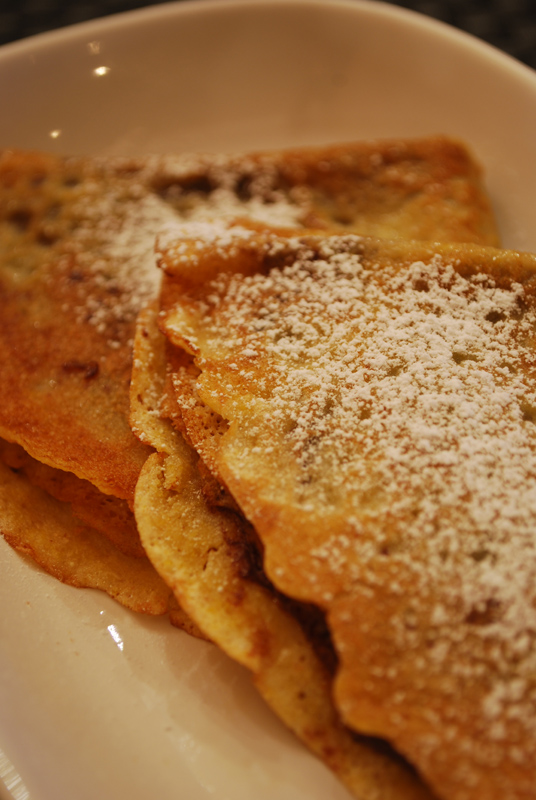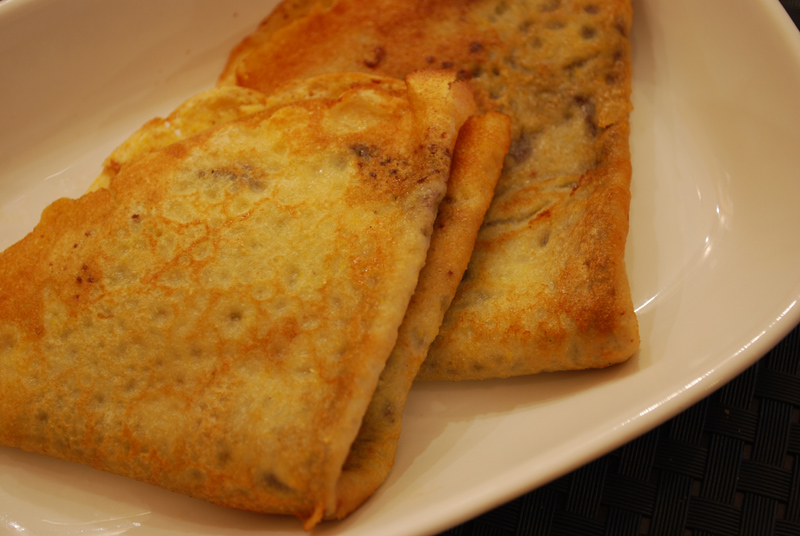Week Fourteen: Take Two!
Okay, so there was nothing really particularly wrong with these crêpes the first time I made them. But then again, they weren’t particularly amazing, either. Oh, the flavor was lovely, don’t get me wrong. But crêpes should be fork-tender and have a slight chewiness to them; these turned out a bit tough, and had rather hard edges. A proper crêpe should yield instantly to a fork and knife; I felt like I needed a guillotine for the ones I produced. I think my pan was too hot (I had the heat all the way to high), or maybe I let the batter sit too long. (Is over 24 hours too long? Not according to my sources.) With all the uncertainty, I definitely wanted another try at these.
This time, thinking that the heat level was my main downfall, I kept the recipe exactly the same, which was a bit of a trick for me. I also kept the method the same, which was also difficult (I just love modifications!). But this time, I kept the heat firmly between medium and medium-high, but mostly tending towards medium heat. I also cooked the batter off about 30 to 40 minutes after whizzing together in the blender, as opposed to two days later.
And do you know what? It worked! These crêpes were so much better this time around! A little butter brushed on the pan, a little swirl of the batter to coat the bottom, and it couldn’t have been better. They came out so perfectly soft, so lightly golden, I just didn’t know what to do with myself. Well, actually, I did know what to do: I smeared them with Nutella, folded them in quarters, and heated them in a pan with some brandy. Despite the savory character of the crêpes themselves, it worked just beautifully. I highly recommend it, especially dusted with a little powdered sugar on top. Could you add some sugar into the batter? Yes, but I don’t really think you need it. Any sweet filling (e.g. Nutella, jam, fruit, etc.) will provide ample sweetness, and the cornmeal in the batter has its own grainy sweetness to add.
Used in savory applications, though, they are also just wonderful. The cornmeal brings not only a light, sweet flavor, but also a slight heartiness not found in the typical crêpe. These lovelies are the ideal foil to any number of fillings, with any range of flavors. I can see an Italian angle to these; think polenta, and fill them with a mixture of ricotta, basil, olive oil, and garnish with diced tomato. For a Tex-Mex flair, think of tortillas, and add pulled pork, cumin, jalapeno, and avocado. Or try for an Eastern take on the corn flavor, by filling with a mixture of scallions, cilantro, garlic, and diced chiles, and top with a nice mango chutney. And, of course, they are superb with Nutella – but what isn’t made better with Nutella, I ask you? These crêpes are so versatile, you may just never look for another recipe again!
Cornmeal Crêpes
Adapted from Gourmet Magazine
Makes about 12 crepes
1 1/4 cups all-purpose flour
3/4 cup yellow cornmeal
1/2 teaspoon salt
2 cups milk, at room temperature
3 large eggs, at room temperature
2 tablespoons unsalted butter, melted, plus additional for brushing skillet
1. Blend flour, cornmeal, salt, milk, eggs, and 2 tablespoons butter in a blender until smooth. Let batter stand at room temperature 30 minutes. If not making crêpes immediately, put batter in refrigerator.
2. Lightly brush a 10-inch nonstick skillet with butter and heat over medium heat until moderately hot, but not smoking. Stir batter, then, holding skillet off heat, pour in 1/3 cup batter, immediately tilting and rotating skillet to coat bottom. (If batter sets before skillet is coated, reduce heat slightly for next crêpe.) Return skillet to heat and cook until just set and pale golden around edges, 10 to 15 seconds. Loosen edge of crêpe with a spatula, then flip crêpe over carefully with the spatula, or your fingertips. Cook until underside is set, about 20 seconds more, and transfer crêpe to a plate. Make additional crêpes in same manner, brushing skillet lightly with butter for each and stacking crêpes on plate as cooked.
Notes:
1. Crêpes should only take about 40 to 60 seconds to cook completely, and they should be just barely golden brown. If you see dark brown spots, you should reduce the heat.


